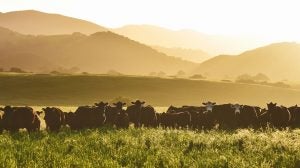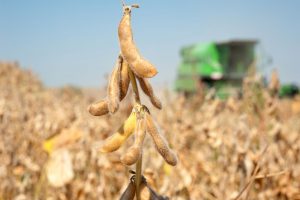The costs of technological upgrades will have to be met with good old fashioned farmer savvy as efficiency demands come into play.
Kids living on farms today have a lot to look forward to as they grow into adulthood, and a whole lot of work cut out for them as well. The World Resources Report “Creating a Sustainable Food Future,” released in December 2018, outlines projections offering both promise and peril for those in all areas of agriculture, be they consumers, producers, processors, or distributors. Produced in partnership with The World Bank and the United Nations, among other agencies, the report addresses a number of ag-related gaps to close before Earth reaches a projected population of 9.8 billion humans in the year 2050.
Agricultural producers might grimace at first blush when reading through materials that , on the surface, promise what appear to be more challenges. But a closer read opens the mind to new markets, new technologies, and billions more customers.
Between the Food Gap, the Land Gap, and the Emissions Gap, the fourth-graders of 2019 have a lot to consider if they look to be farming just three decades from now when in their 40s. How can producers raise more food on less land while maintaining, let alone reducing, carbon emissions? Researchers utilized a new model, GlobAgri-WRR, developed in partnership with Le Centre de cooperation international en recherché agronomique pour le developpement (CIRAD), L’Institut national de la recherché agronomique (INRA), World Resources Institute (WRI), and Princeton University. That work bears considerable fruit in the ideas for projects and markets going forward.
The Food Gap
Researchers define the Food Gap as the difference between food volume produced in 2010 and the amount necessary to feed a 9.8 billion-human population in 2050. Estimated to be a difference of 7,400 trillion calories, this means the world’s agricultural community would need a 56 percent increase in crop calories in 2050 than it produced in 2010. Consumption of milk and meat — foods that rely heavily on pasture for their production — is likely to grow by 68 percent, a rate that exceeds past growth, such as what was seen between 1962 and 2010.
Addressing this demand requires a dynamic approach that matches reduced waste and more efficient consumption alongside heightened production. Simplistic thinking simply won’t cut it.
“Frequent claims that the world already has an overabundance of food and could meet future needs without producing more food are based on an unrealistic, even if desirable, hypothetical,” the report says. “It presumes that the world not only consumes fewer animal products per person, as this report encourages, but by 2050 eliminates nearly all meat consumption; that people shift from meat to vegetables and legumes and consume the same high-yield crops now used for animal feed; that all food loss and waste is eliminated; and that food is distributed just enough and no more than to meat nutritional needs of every person in the world.”

Livestock producers will certainly be dismayed with the tone of the researchers when it comes to meat production, as the report continuously encourages a shift toward more plant-based diets. However, considering the increased number of hungry people, as well as the reality expressed by those same researchers, the prospects for meat production actually seem quite positive.
While the report does express a consistent theme citing livestock production as, at present, a massive user of space and energy, there’s little question that efficiency improvements answer most of those concerns. Likewise, with billions of additional people to feed, even a reduction in meat-consumption per person will still necessitate an increase in production across the population. Supply-side solutions offered by the researchers include improvements to the livestock and pasture productivity, increasing the number of fisheries and their productivity, increasing opportunities for women in agriculture as both an income opportunity as well as a method of providing for household nutrition. A combination of governmental and private sector funding mechanisms would be needed to reach these aims.
The Land Gap
Researchers estimate the difference between global agricultural land area in 2010 and the area required in 2050 even if crop and pasture yields continue to grow at past rates to be 593 million hectares, nearly 1.5 billion acres, or roughly twice the size of India.
The good news is: Land values are certain to rise. The bad news is: Good ag land is being chopped up for other uses every day. In 2018, nearly half of all vegetated land on Earth is occupied by crops and pasture, but between 1962 and 2010, nearly 500 million hectares of forests and woody savannas were cleared for agriculture as other grounds went the way of suburban sprawl and commercial development. That means people are running out of ground to farm quickly, and as the old saying goes, they’re not making any more of it.
Demand-side solutions offered include a strategic reduction in food loss and waste between farm and fork, as well as more thought put to the competition between bioenergy crops and food production. The good news for those interested in research and technology are the supply-side solutions offered, which include improved crop genetics, fertilizer, and increased usage of cropland so as to keep soil nutrients high. A recurring theme throughout the report is the emphasis on soil productivity and the need to maximize this across all boards. No doubt, those producers able to utilize technology by way of greenhouses and anaerobic digesters, which convert animal waste into methane gas and in turn electricity, will find themselves a welcome participant in the marketplace going forward. Both seed and animal genetics will continue to be an area of importance as producing bigger and more on fewer and less is required.
The Emissions Gap
The Greenhouse Gas Mitigation Gap (GHG) represents the gap between agriculture-related GHG emissions projected for 2050 and the target believed necessary to stabilize climate change at globally agreed-to levels. Using the GlobAgri-WRR model, researchers project total agricultural GHGs to be roughly 15 gigatons in 2050, up from 12 gigatons in 2010. The actual impact of this increase on global climate and temperature is admittedly tougher than predicting the weather, in that a multiplicity of other factors weigh in, from new construction requisite to house more people to different types of energy production. That said, those in agriculture are concerned about increased warming and its potential to change seasons as well as access to rainfall and land currently near water. According to 2014 Intergovernmental Panel on Climate Change reports, models project on average, that without adaptation to climate change or an address to emissions, global crop yields are likely to decline by 5 percent by 2050, with steeper declines to follow.
Reduction of carbon emissions is a multi-faceted goal involving many industries, and to this end, offers perhaps the most exciting opportunities for young people today. Among the recommendations offered in terms of reducing usage and consumption, the researchers point out increased efficiencies in engineering, tools, and a shift toward solar and wind energy would help. This could prove profitable to a new generation of ag-engineers and technologists, who seek to convert resources into energy, such as anaerobic digesters which generate methane gas and electricity from manure.
“Evan an extremely sophisticated system for managing pig manure in North Carolina (United States), using a series of treatment tanks to eliminate all air and water pollution, would only cost an additional $22 per ton of mitigation,” the report says. “This system would add only around 2 percent to the retail price of pork.”

Vertical integration is nothing to new to farmers, the original multi-taskers. And as growing more with less becomes increasingly critical, than use of solar panels to power a farm will achieve both objectives — economic and environmental. Electric tractors achieve both ends already, as farmers can partner solar panels with battery technology to drastically reduce fuel costs, all while reducing carbon emissions. Good news for farmers needing to raise more hay to feed more livestock on perhaps less ground going forward.
Another area for potential growth is presented in the recommendation to reforest abandoned and unproductive agricultural lands. Orchards and timber represent a two-edged method of addressing these issues as producers can meet the increased demand for product while using the trees to return more oxygen to the atmosphere, converted naturally from the carbon dioxide.
21st Century farming
Families looking to keep their kids on the farms have reason to be optimistic in that more hungry Earthlings represent more potential customers. Potential costs of technological upgrades will have to be met with good old fashioned farmer savvy as efficiency demands come into play. Alternative energy sources, better hybrids and more attention to land use will all play a role in the challenges, but ultimately, more hungry people mean more opportunity going into tomorrow.



